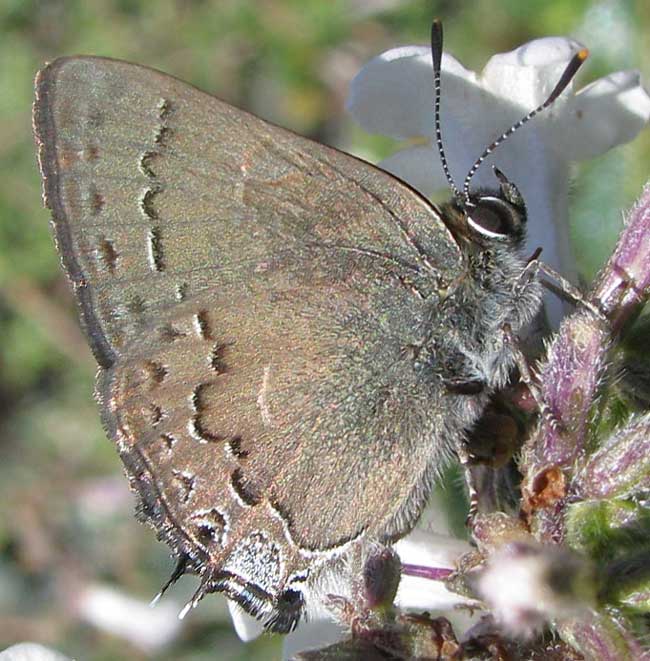Excerpts from Jim Conrad's
Naturalist Newsletter

from the June 21, 2009 Newsletter, issued from the Siskiyou Mountains west of Grants Pass, Oregon:
HEDGEROW HAIRSTREAK
I know that in the June 7th Newsletter I already introduced you to a species of hairstreak butterfly, but I've run into another, and it's worth repeating in order to emphasize the enormous diversity found in this interesting little butterfly group. Look at the one above.
Bea in Ontario helped identify that as the Hedgerow Hairstreak, SATYRIUM SAEPIUM. You can see what qualifies it as a hairstreak: Its small size, gray- brown color, and those neat little "tails" on its lower hind wings, which it wiggles up and down simulating the head's probing antenna, with the consequence that predators might attack the wrong end and thus save the poor hairstreak.
About a thousand hairstreak species are recognized. Hedgerow Hairstreaks bear shorter "tails" than most, and differ from other hairstreak species by the patterns of spots and lines on their wings. In fact, when you're thumbing through the field guide's many pages of hairstreak species you feel like you're decoding a cryptic message because you have to pay attention to whether this little spot is inside or outside of that spot, this little line bending inward or outward, the relative position of this pattern is in the same place as that pattern...
It's amazing that a couple of little spots you wouldn't otherwise notice can mean a whole different species -- a whole different genetic heritage, set of habitat requirements, of distribution, of behavior, and more. If you enjoy Bach fugues, you'll love hairstreaks. You might enjoy comparing our Hedgerow Hairstreak picture with those of the Nelson's and Northern Hairstreaks linked to on our butterfly-index page at http://www.backyardnature.net/n/ins-butt.htm.
Caterpillars of Hedgerow Hairstreaks feed on the same buckthorn bushes, genus Ceanothus, as the above Pale Tiger Swallowtail, plus the two species occupy the same general mountain landscape and distribution, which is no coincidence; the two species are similarly dependent on Ceanothus bushes, and live wherever Ceanothus lives.
Hairstreaks are members of the Gossamerwing Family, the Lycaenidae, the Hairstreak Subfamily, the Theclinae. They're most abundant in tropical habitats.